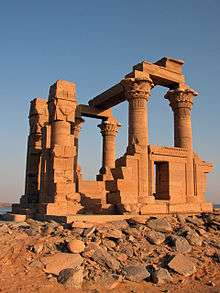Kiosk of Qertassi


The Kiosk of Qertassi is "a tiny Roman kiosk with four slender papyrus columns inside, [and] two Hathor columns at the entrance."[1] It is a small but elegant structure that "is unfinished and not inscribed with the name of the architect, but is probably contemporary with Trajan's Kiosk at Philae."[2] According to Günther Roeder--the first scholar to publish research on this building--the kiosk of Qertassi dates to the Augustan or early Roman period.[3] The structure "is only twenty-five feet square, and consists of a single Hathor court oriented north or south, and originally surrounded by fourteen columns connected by screen walls."[4] Of the 14 pillars, only 6 have survived in place.[5] The pillars or columns were made of brown sandstone; the structure itself was "perhaps connected to a small temple on the East Bank [of the Nile] which was still in existence in 1813."[6]
This charming kiosk has now been moved to the site of New Kalabsha in Southern Egypt but "once stood to the entrance to the sandstone quarries" of Qertassi.[7] Its capitals "are decorated with Hathor heads, in honour of the goddess who was [the] patron of quarry-men and miners.[8] Since Hathor was often associated with Isis, as she is at Philae, it has been suggested that "this kiosk and the small temples of Dabod and Dendur were way stations on the processional route taken by priests bearing the image of Isis around Lower Nubia, which was held to be her estate."[9] Due to the paucity of timber in the arid region of Nubia, the kiosk's roof was constructed with sandstone slabs that were supported by architraves on its long sides.[10]
References
- ↑ Chicago House Bulletin "The Sitts go to sea: Egypt doesn't end at Aswan" by the University of Chicago, Vol.7 No.2 (April 15, 1996)
- ↑ Christine Hobson, Exploring the World of the Pharaohs: A complete guide to Ancient Egypt, Thames & Hudson 1993 paperback, p.185
- ↑ Günther Roeder, Debod bis Bab kalabsche, (Cairo, 1911-12), pp.146-179
- ↑ Margaret A. Murray, Egyptian Temples, Dover Publications, 2002. p.192
- ↑ Murray, pp.192-193
- ↑ Dieter Arnold, Nigel Strudwick, Sabine Gardiner, The Encyclopaedia of Ancient Egyptian Architecture, I.B. Tauris Publishers, 2003. p.192
- ↑ Lorna Oakes, Pyramids, Temples and Tombs of Ancient Egypt: An Illustrated Atlas of the Land of the Pharaohs, Hermes House:Anness Publishing Ltd, 2003. p.209
- ↑ Oakes, p.209
- ↑ Oakes, p.209
- ↑ Dieter Arnold, Temples of the Last Pharaohs, Oxford University Press, 1999. p.240
External links
| Wikimedia Commons has media related to Kiosk of Qertassi. |
Coordinates: 23°57′37″N 32°52′03″E / 23.96028°N 32.86750°E